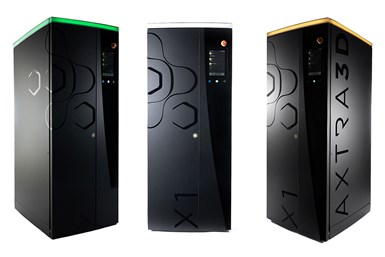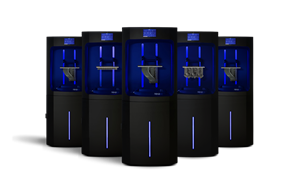Axtra3D’s X1 Series 3D Printers Powered by Vat Polymerization Technologies
The X1 and Revox X1 3D printers are powered by vat polymerization technologies, including Hybrid PhotoSynthesis (HPS), TruLayer technology and the Intelli-Cartridge system to deliver fine resolution, large print area, excellent surface quality and high speed in one machine.
X1 Series Printers from Axtra3D enable production speed and quality without the tradeoffs. Photo Credit: Axtra3D
Axtra3D says its X1 and Revox X1 3D printers are powered by next-generation vat polymerization technologies, including Hybrid PhotoSynthesis (HPS), TruLayer technology and the Intelli-Cartridge system. Together these technologies are said to deliver fine resolution, large print area, excellent surface quality and high speed in one machine.
According to the company, familiar SLA, DLP and LCD 3D printing technologies all require tradeoffs. HPS is a hybrid process designed to enable speed and quality without compromise. This technology combines two different light sources, DLP and laser, to leverage the best of each without the tradeoffs of either. HPS coalesces the energy from the two light sources, creating a harmonized light engine that efficiently harnesses the power and competencies of the two sources.
HPS also delivers the speed of DLP and LCD processes with the ultrafine resolution of SLA, all without familiar aliasing defects, anisotropy or tiny build volumes. The large build area of Axtra3D’s HPS-powered systems produce isotropic parts with fine feature finish. Quality, speed, scale and significantly reduced postprocessing for surface finish are said to deliver new possibilities for medical, dental and other meticulous industries.
Axtra3D’s TruLayer technology is on every X1 Series printer, offering several distinct advantages. It enables rapid detachment of the active print layer from the vat membrane and no limitations to the cross sections being printed, including large and bulky cross sections. Another advantage is the nondegenerative vat membrane, which means fewer membrane replacements. It also offers the ability to print highly viscous resins. Faster speeds, better layering and deep materials understanding are said to power this process, enabling superior separation and adaptive performance.
The Intelli-Cartridge system adds user-friendliness to resin material handling. Debuting with the X1 Series, Intelli-Cartridge enables both open and closed material configurations, offering users the highest level of freedom to ensure they have the materials capabilities for their specific applications. Axtra3D is poised to offer third-party and in-house materials directly, and has validated filled and unfilled resins from some of the best-known brands active in 3D printing today.
With the Intelli-Cartridge, materials are virtually spill-proof and free of contamination. It actively dispenses material to the vat and also collects the return material from the vat. The Intelli-Cartridge enables 3D printing of high-performance materials by offering agitation, heating and filtering mechanisms.
Axtra3D’s X1 Series printers include the production-grade Lumia X1 and the budget-friendly Revox X1 which is a 4K DLP system powered with TruLayer technology. The build volume and Intelli-Cartridge capabilities of the Lumia X1 are identical for the Revox X1.
The Lumia X1 is said to offer unrivaled quality at speed. Designed to outperform photopolymer 3D printers available to date, the HPS-powered Lumia X1 offers 24/7 lights-out production. It is also equipped with TruLayer technology to offer excellent production economics, uptime, repeatability and printability. Possible only with HPS + TruLayer technology, users gain the speed of 3D printing with the fine finish of injection molding. It also offers a large build area with 45-micron resolution, all with the material handling ease of Intelli-Cartridge.
The Revox X1 system is poised to deliver unprecedented 4K DLP 3D printing. It is a high-quality, reliable and repeatable DLP 3D printer at an attractive entry price point for budget-limited customers who can accept DLP part quality. The only difference from the otherwise-identical Lumia X1 is that the Revox X1 does not harness HPS technology. If, however, a customer later wants to commit to HPS, an upgrade path from Revox X1 to Lumia X1 will be offered. This industrial 3D printing platform is built using high-end optoelectronics with top-of-the-line mechatronics to ensure a highly repeatable print process ready to work from day one.
Related Content
8 Cool Parts From RAPID+TCT 2022: The Cool Parts Show #46
AM parts for applications from automotive to aircraft to furniture, in materials including ceramic, foam, metal and copper-coated polymer.
Read MoreHow Large-Format 3D Printing Supports Micro-Scale Hydropower
There is potential hydroelectric power that has never been unlocked because of the difficulty in capturing it. At Cadens, additive manufacturing is the key to customizing micro-scale water turbine systems to generate electricity from smaller dams and waterways.
Read MorePossibilities From Electroplating 3D Printed Plastic Parts
Adding layers of nickel or copper to 3D printed polymer can impart desired properties such as electrical conductivity, EMI shielding, abrasion resistance and improved strength — approaching and even exceeding 3D printed metal, according to RePliForm.
Read MoreHow to Improve Polymer AM Productivity 20X
A fast cycle time is critical to efficient production 3D printing, but it’s not the only thing. How you choose the right parts for AM, prepare jobs for production, and manage post processing will have just as big an impact on total 3D printing throughput. It all needs to work together to achieve maximum productivity.
Read MoreRead Next
3D Printing Brings Sustainability, Accessibility to Glass Manufacturing
Australian startup Maple Glass Printing has developed a process for extruding glass into artwork, lab implements and architectural elements. Along the way, the company has also found more efficient ways of recycling this material.
Read MoreAt General Atomics, Do Unmanned Aerial Systems Reveal the Future of Aircraft Manufacturing?
The maker of the Predator and SkyGuardian remote aircraft can implement additive manufacturing more rapidly and widely than the makers of other types of planes. The role of 3D printing in current and future UAS components hints at how far AM can go to save cost and time in aircraft production and design.
Read MoreHybrid Additive Manufacturing Machine Tools Continue to Make Gains (Includes Video)
The hybrid machine tool is an idea that continues to advance. Two important developments of recent years expand the possibilities for this platform.
Read More






















